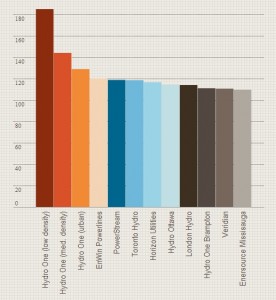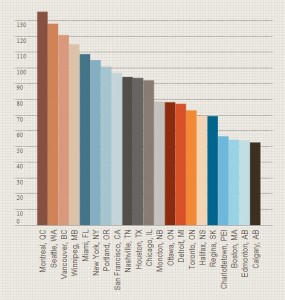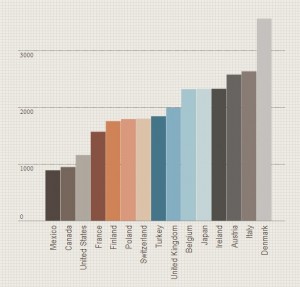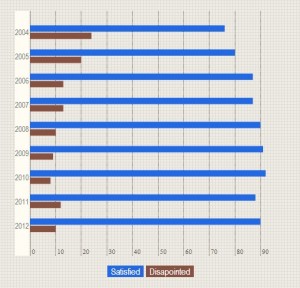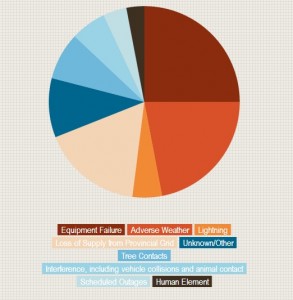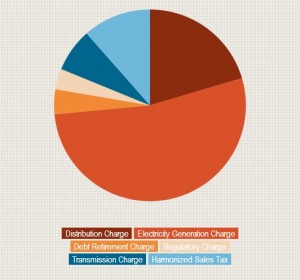Visiting Parliament Hill in – 30 degree weather may not be what many would call a pleasant night out, but for 23-year-old Queen’s University graduate Jennifer Grove, fighting the cold is just one way of experiencing the capital and giving back.
Grove moved from Kingston to Ottawa following graduation in 2011 when local engineering firm MMM Group offered her a full-time position as an urban planner.
Being new to the city, Grove was eager to meet like-minded people and experience the capital as a resident rather than a tourist.
Grove began searching for volunteer opportunities on an online community database called ottawavolunteerlounge.ca. The website, run by the not-for-profit member-based organization Ottawa Festivals, matched her interests with corresponding positions in the city.
“I’m relatively new to Ottawa so I thought it would be a good way to get out and experience some of Ottawa’s events,” said Grove.
“I’ve also met a lot of people from around the city, so it’s been really great.”
According to volunteer lounge administrator Kimberly McCarthy-Kearney, once volunteers create a profile, they can have their personalities matched to various festivals and events.
Grove was just one of 70 volunteers at the annual Christmas Lights ceremony on Dec. 5 this year, with + 7 degrees being much more bearable than the – 30 experienced by volunteers last December.
But the ceremony celebrated more than just the beginning of the holiday season.
In recognition of the millions of volunteers world-wide who dedicate their time, effort and personal finances to thousands of cultural activities, festival organizers at Christmas Lights announced Dec. 5 as International Volunteer Day, a day first recognized by the United Nations (UN) in 1985.
According to the 2011 State of the World’s Volunteerism Report by the UN, volunteers contribute to the progress, cohesion, and resilience of communities.
With 1.4 million Canadian volunteers reported in March 2013 in the sector of arts and culture alone, volunteerism is just as significant now as it was in 1985.
The number of volunteers in the National Capital Region reached 12,000 in 2011 with at least 141,000 hours of community work.
The high average of volunteer hours in Ottawa not only demonstrates the importance of arts and culture in the community, but also the level of commitment to such causes.
The festival industry itself relies on volunteers to plan, organize, and execute some of the nation’s biggest events including Christmas Lights, Winterlude and Canada Day.
“Volunteers are the lifeblood of the festival sector,” said Executive Director of Ottawa Festivals, Barb Stacey.
“Without their enthusiasm and commitment, many of the events simply would not happen.”
Although the Canada Dance Festival employs two staff members per year, other events such as Ottawa Fashion Week and Cracking-Up the Capital rely 100 per cent on volunteers who dedicate up to 4,000 hours in the coming weeks before each show.
“Fashion week is entirely volunteer run right from the board of directors down to the planning team,” said McCarthy-Kearney.
“They just don’t have the funding to hire staff either on a part-time or full-time basis.”
Following the economic recession of 2008, the Cultural Human Resources Council of Canada (CHRC) released a report on the effect of the global recession on Canada’s creative economy, noting that the cultural sector would be hit harder than the overall Canadian economy.
The CHRC also expected the cultural sector to drop by 4.8 per cent from 2008–2009.
Data from the 2012–2013 Canadian Heritage Report on Plans and Priorities also points to significant decreases in government spending.
The report outlines the federal government’s initiative to take full advantage of digital technology, invest in communities and celebrate Canadian history.
Although the mandate outlines its commitment to the arts, the cultural industry and heritage sectors were expected to receive less funding from 2011 to 2012 by $3.1 million, with full-time human resources also decreasing.
Before 2013, the National Capital Commission (NCC) was responsible for coordinating Winterlude, Canada Day, and Christmas Lights.
This past year, however, the NCC’s responsibility went from three of the largest festivals in Canada to much smaller events such as fall and ski patrol in Gatineau Park and the Maplelawn Historic Garden.
According to Canadian Heritage employee Jeanine Tartarian, the decision to move Canada Day, Winterlude, and Christmas Lights to Canadian Heritage was a decision made by the federal government following the 2013 federal budget.
As outlined by The Canadian Heritage mandate, the department’s focus is to promote culture, heritage, and the official languages. From 2012-2013, Canadian Heritage hired 1,406 volunteers to work at different events in the region.
“The volunteers, of course, are an added value,” said Tartarian.
“The event should still be happening if we don’t find the amount of volunteers we need, but it does not replace a job. The volunteers are here to help and to add a value.”
As outlined by Tartarian, volunteers within the Capital Experience Branch work mostly as first aid and information officers.
Tartarian, who works as a volunteer coordinator at the Capital Experience Branch in Gatineau, is concerned about the future of arts and culture in the nation’s capital.
“If you visit capitals across the world, there are lots of things happening,” said Tartarian.
“I think in Ottawa, we still have a lot to do in terms of attracting people over. Yes, we do have events but nothing compared to other cities. It’s sad because we do not have the kind of money that goes with it.”
Although the NCC and Canadian Heritage share festival responsibility, Tartarian was happy to report that the number of employees within the department has not decreased in the past few years.
“We had to stay the same because they couldn’t cut more than that. It’s hard to say okay, well, we can downsize because we are already at the bare minimum,” said Tartarian.
Canadian Heritage also recruited 1,299 volunteers in 2011 and close to 1,410 in 2012 because of the Juno Awards at then Scotiabank place.
Volunteerism within the city appeals to varying demographics within the population. New-comers to Canada, high school students and retired citizens all take an interest in contributing to a cause, getting community hours or just meeting new people.
According to Busy Bodies, a volunteer news pamphlet published by Canadian Heritage, people from all demographics are eager to spend their time contributing to different events.
One of them is Canadian newcomer, Dolores Houedjissin, who still felt like a stranger after four years because she was not involved in the community.
“I was telling myself that I had to find a way to get involved and form relationships that would help me to experience and understand Canadian culture,” said Houedjissin.
“Because of my first volunteering activity, I am not afraid of winter and I have learned to take full advantage of the snow.”
Aside from contributing to festivals and other cultural events, volunteering also improves social interaction and inclusion. According to Houedjissin, meeting new people is an important part of integration.
“What I like most about volunteering is getting to know people and having a great time,” said Houedjissin.
“The atmosphere helped me to come out of my shell.”
Tartarian also noted the importance of volunteerism for immigrants and other demographics, such as students, who are looking for community hours or real-world experience.
“Depending on the age, some people do it for different reasons. If you’re a student, then you are probably looking for experience,” said Tartarian.
“If you’re a newcomer to Canada, you might be looking to be integrated.”
Age variation seems to be a factor, too. According to statistics gathered by Canadian Heritage, 41 per cent of all volunteers for 2012 were people 18 years of age or younger, while only 12 per cent of volunteers were people between the ages of 18-24.
And yet, according to Carleton University graduate Kyla Lee, 22, and volunteer at Ottawa Folk Festival and Beau’s Oktoberfest, a large number of the volunteers were retired individuals.
“In my experience, there were a lot of older people volunteering and I think that’s partially because they have a lot more free time,” said Lee.
“There’s kind of that gap – there’s a lot of younger people like students volunteering – and a lot of older people probably because we have a lot more free time.”
Lee also noticed a significant gender gap in the people she worked with.
“I think there’s a lot more women than men. I’m not really sure why that is but I noticed that the men who were volunteering were with their wives,” said Lee.
“It seemed kind of something they were enticed to do.”
Kyla’s observations coincide with other statistics gathered by Canadian Heritage. Reports show that 64 per cent of all volunteers for the department in 2012 were female, while only 36 per cent were male.
According to McCarthy-Kearney, some women may have more available time to volunteer.
“I hate to say it because I’m a bit of a feminist,” said McCarthy-Kearney.
“But probably more women volunteer because their husbands’ career has them moving more and they don’t have the opportunity to get a full-time job, so they volunteer in their new community.”
McCarthy-Kearney also pointed to the fact that a significant number of women stay home with their children and may wish to volunteer before re-entering the work force.
In both Canada and the United States, however, the proportion of wives who are primary wage-earners has dramatically risen since the 1990s.
In fact, sociological studies have observed that at the end of the last millennium, wives out earned their husbands in almost a third of all North-American families.
The work-role model may explain why Lee and Kearney both noticed the number of female volunteers versus male.
Paid work in most countries is highly gendered and that does not exclude Canada.
Sociologist Adie Nelson reported in Gender in Canada that the male work-role model dictates that men are expected to work in paid employment from graduation until retirement. Only after retirement is it socially acceptable for men to volunteer, whereas women are accepted and encouraged to engage in unpaid work.
With each individual who decides to volunteer, however, a unique set of skills applies and the city benefits economically as well.
“Winterlude attracts a lot of people and even economically, it’s good for the city and there’s lots of money involved, “said Tartarian.
“I would hope we could get to do more events and really be on the map.”
Festivals in particular draw tourists to Ottawa, with almost 57 per cent of tourists visiting the capital solely because of festivals.
According to reports by Ottawa Festivals, the total economic activity in Ottawa every year is close to $49 million with tourists visiting downtown restaurants, shops, and hotels.
It’s clear that the community, volunteers and organizations all benefit from cultural events in the city, but it is essential to recognize how important festivals are to Canadians.
“The volunteers are people who give their time – they do it by choice- so you’re not obliged to do some hours,” Tartarian said.
“It’s about being part of the event or to contribute to the community.”
Volunteers are an important source of labour for these events, but as former Algonquin College student Brian Be said, it’s also about getting free access to live entertainment.
“The benefits are that you get to meet people, you get to go to the festival for free and sometimes you are given free meals or beer,” said Be.
“If it’s a smaller festival, you might be fed in the same place as artists and it’s a cool way to meet them.”
With decreased funding, festival organizers may have to find new ways to recruit. Some of these events may also require volunteers to return if recruitment does not go as marketed.
With free access to meals, beer, and at times even backstage passes at Canada Day on the hill, how could anyone say no?
Let’s just hope the federal government continues to say “yes.”
According to Carleton University graduate Kyla Lee, 22, and volunteer at Ottawa Folk Festival and Beau’s Oktoberfest, a large number of the volunteers were retired individuals.
“In my experience, there were a lot of older people volunteering and I think that’s partially because they have a lot more free time,” said Lee.
“There’s kind of that gap – there’s a lot of younger people like students volunteering – and a lot of older people probably because we have a lot more free time.”
Lee also noticed a significant gender gap in the people she worked with.
“I think there’s a lot more women than men. I’m not really sure why that is but I noticed that the men who were volunteering were with their wives,” said Lee.
“It seemed kind of something they were enticed to do.”
Kyla’s observations coincide with other statistics gathered by Canadian Heritage. Reports show that 64 per cent of all volunteers for the department in 2012 were female, while only 36 per cent were male.
According to McCarthy-Kearney, some women may have more available time to volunteer.
“I hate to say it because I’m a bit of a feminist,” said McCarthy-Kearney.
“But probably more women volunteer because their husbands’ career has them moving more and they don’t have the opportunity to get a full-time job, so they volunteer in their new community.”
McCarthy-Kearney also pointed to the fact that a significant number of women stay home with their children and may wish to volunteer before re-entering the work force.
In both Canada and the United States, however, the proportion of wives who are primary wage-earners has dramatically risen since the 1990s.
In fact, sociological studies have observed that at the end of the last millennium, wives out earned their husbands in almost a third of all North-American families.
The work-role model may explain why Lee and Kearney both noticed the number of female volunteers versus male.
Paid work in most countries is highly gendered and that does not exclude Canada.
Sociologist Adie Nelson reported in Gender in Canada that the male work-role model dictates that men are expected to work in paid employment from graduation until retirement.
Only after retirement is it socially acceptable for men to volunteer, whereas women are accepted and encouraged to engage in unpaid work.
With each individual who decides to volunteer, however, a unique set of skills applies and the city benefits economically as well.
“Winterlude attracts a lot of people and even economically, it’s good for the city and there’s lots of money involved, “said Tartarian.
“I would hope we could get to do more events and really be on the map.”
Festivals in particular draw tourists to Ottawa, with almost 57 per cent of tourists visiting the capital solely because of festivals.
According to repots by Ottawa Festivals, the total economic activity in Ottawa every year rounds close to 49 million with tourists visiting downtown restaurants, shops, and hotels.
It’s clear that the community, volunteers, and organizations all benefit from cultural events in the city, but it is essential to recognize how important festivals are to Canadians.
“The volunteers are people who give their time – they do it by choice- so you’re not obliged to do some hours,” Tartarian said.
“It’s about being part of the event or to contribute to the community.”
Volunteers are an important source of labour for these events, but as former Algonquin College student Brian Be said, it’s all about getting free access to live entertainment.
“The benefits are that you get to meet people, you get to go to the festival for free and sometimes you are given free meals or beer,” said Be.
“If it’s a smaller festival, you might be fed in the same place as artists and it’s a cool way to meet them.”
With decreased funding, festival organizers may have to find new ways to recruit. Some of these events may also require volunteers to return if recruitment does not go as marketed.
With free access to meals, beer, and at times even backstage passes at Canada Day on the hill, how could anyone say no?
Let’s just hope the federal government continues to say “yes.”
The pie chart above showcases the different age groups of those who volunteer in the capital. I thought it was important to display the different age gaps because it was a main focus of my story, with young people and seniors having the highest volunteer rates. I also relate the participants to a discussion of unpaid work and how valuable it can be to people of all ages, but also how problematic free labour is when an industry relies on it. This data was obtained through Canadian Heritage directly.
The bar graph notes the number of volunteers and the total number of combined volunteer hours at each Canadian Heritage event. This data was a detrimental aspect of my story because the high levels of involvement showcase the importance of arts in culture in Ottawa and specifically, who finds it important. With decreased funding, arts and culture could cease to have any real influence, but with the help of volunteers today, it’s still very much alive. I also obtained these numbers at the Department of Canadian Heritage.



